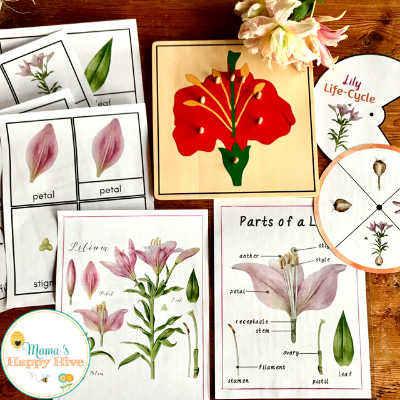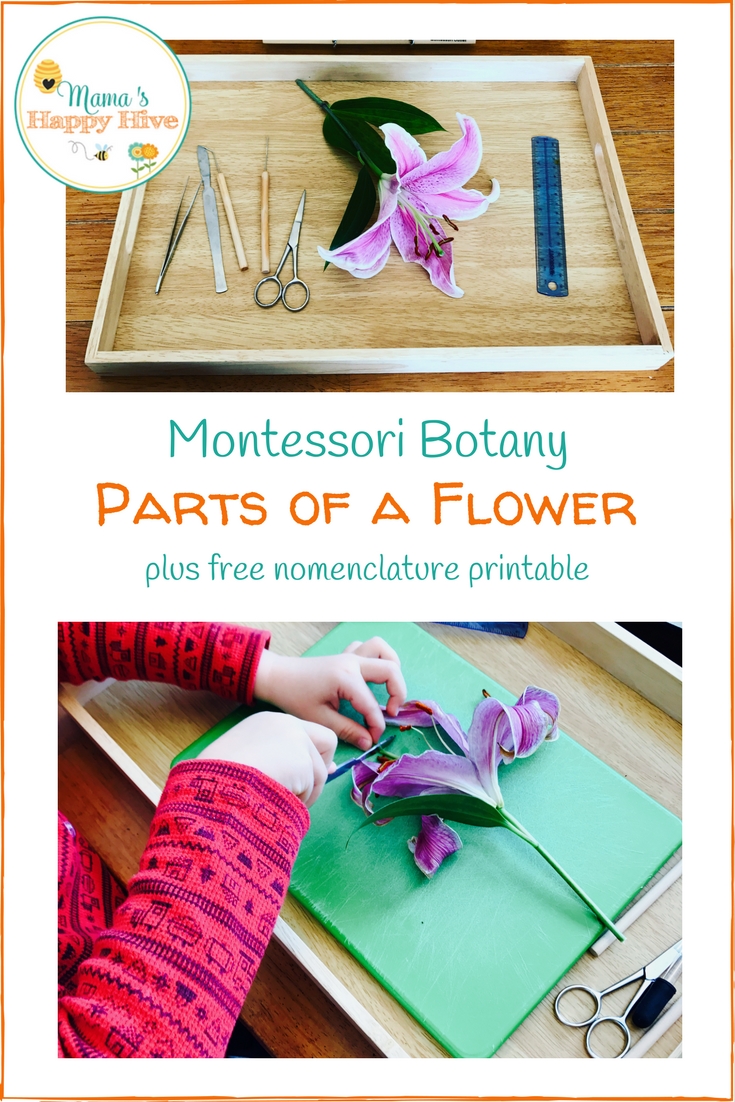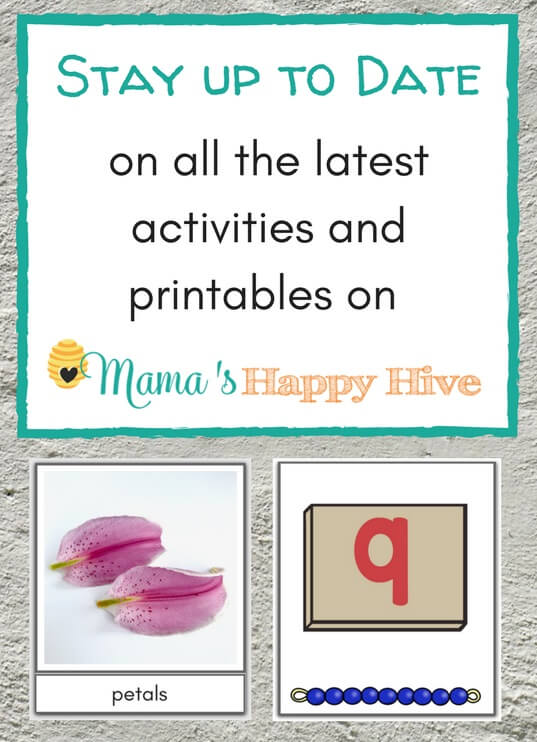My husband bought me a gorgeous bouquet of red roses and lilies for Valentine's Day. He graciously let us disassemble a lily for our Montessori botany lesson to study the parts of a flower. Plus, spring is in the air and we like to follow the seasons in our Montessori inspired homeschool. So this was the perfect opportunity to examine a beautiful sweet smelling lily. In this lesson we observed the flower, dissected the flower parts, examined the intricate details of the flower, and used the Montessori flower puzzle for matching work.

Materials Needed for this Montessori Botany Lesson
- Dissecting Kit (see the photo below for an example)
- Flowers for dissecting - A lily matches the Montessori flower puzzle nicely.
- Montessori Flower Puzzle
- Parts of the Lily (flower) - Nomenclature Cards
- Parts of a Lily (real images) FREE (for Subscribers to MHH Newsletter)
- "From Seed to Plant" Book
- Tray and Cutting Board
- Magnifying Glass
- Botany Brainy Kit (optional)
 Examining the Flower as a Whole
Examining the Flower as a Whole
Little Bee and I took a moment to examine the beautiful flower as a whole before dissecting it into its various components. We read the book, "From Seed to Plant" and turned to the page that illustrates the parts of a flower. We closely examined the flower to identify the following parts of the flower:
- stem
- sepal
- pistil
- stamens
- stigma
- pollen
- petals
 Dissecting the Parts of the Flower
Dissecting the Parts of the Flower
Before Little Bee dissected the flower, I prepared the dissecting tray for him to use. The dissecting tray contained instruments from a dissecting kit (this was part of our botany Brainy Kit) laid out and ready to use. The kit contained scissors, forceps, scalpel, needles, and a measuring stick. Little Bee is four years old and has been instructed on how to use a knife. This is very important as you would not want to give your child a scalpel without knife safety awareness and proper training on how to use a knife. I also placed a cutting board inside the tray to save our tray from cut marks.
Little Bee wasn't given a lot of instructions on how to dissect the flower. I let him decide what he wanted to dissect first. As he dissected the various parts of the flower, I reminded him of the names of the flower parts. I also discussed with him about the function of the flower parts as he examined them.
Taking a Closer Look
Once the flower was disassembled into its various parts, Little Bee took out his magnifying glass to examine the parts closer. As he examined, we noted the beauty and intricate detail in each flower piece. The petals have lines, swirls, and dots. The stamens have flaky orange tips filled with pollen. Every piece is magnificently crafted and glued together by our Creator. 
Matching Work with the Montessori Flower Puzzle
The last activity that we did was to match the parts of the flower to the pieces of our Montessori flower puzzle. Little Bee helped to match the velvet soft petals of the lily to the wooden puzzle petals. He matched the stem, sepal, pistil, stamens, and stigma to their matching wooden puzzle pieces. 
This simple yet effective lesson on the parts of a flower is a lovely way to introduce a young child to scientific study and observation. The child begins to learn the physiology, structure, genetics, ecology, distribution, classification, and economic importance of the plant and the role it plays on earth. This study can start simply and then as the child matures, it can be repeated in more and more detail.
Thank you for your visit!
Parts of a Lily & Lily Life-Cycle Printables

You can find these gorgeous watercolor parts of a lily and lily life-cycle printables in our "Learning with Play" shop!
Parts of a Lily Montessori 3-Part Cards & Worksheets
Lily Life-Cycle Montessori 3-Part Cards & Spinner
March: Earth Science
Please visit the other Montessori bloggers in this series listed below:
- Teaching Kids About Pollution - Air, Land, & Water Pollution Printables | Natural Beach Living
- Weathering and Erosion Printables (24 3-Part Cards) | The Natural Homeschool
- Montessori-Inspired Phases-of-the-Moon Playdough Tray | Living Montessori Now
- Montessori Botany: Parts of a Flower | Mama’s Happy Hive
- Montessori Inspired Volcano Study | The Kavanaugh Report
- Montessori Inspired Activities for Earth Science | The Pinay Homeschooler
- Montessori Science: Fruit Dissection | Christian Montessori Network
- DIY Agate Candy Slices: Candy Science | Sugar, Spice & Glitter
- DIY Land, Water, and Air Jars With Free Printables | Uno Zwei Tutu
- Water Cycle and Weather Unit | Welcome to Mommyhood





I love this activity. It is so simple and yet children can learn so much from it. And the printables are gorgeous! Now, I need to get a dissecting kit for my daughter.
Thank you so much Isabel!
I really love that you explored the parts of a flower with a real one! What a great way to explore nature and really learn. I can’t wait to do this with Y! We just got some lovely flowers that have the perfect one to dissect like this
In our childhood, we used to put rose petals among our favorite books. It would make the book smell like roses.
Recently, it has been covered with epoxy for decoration and used for decorative purposes in places such as bathrooms and living rooms.
That is a lovely idea!
Montessori toys are very effective to grow toddlers natural curiosity for learning new things. No force is necessary. Children automatically directed to learn and do new things when they find it interesting. This flower making process is awesome. It will increase the creativity more.